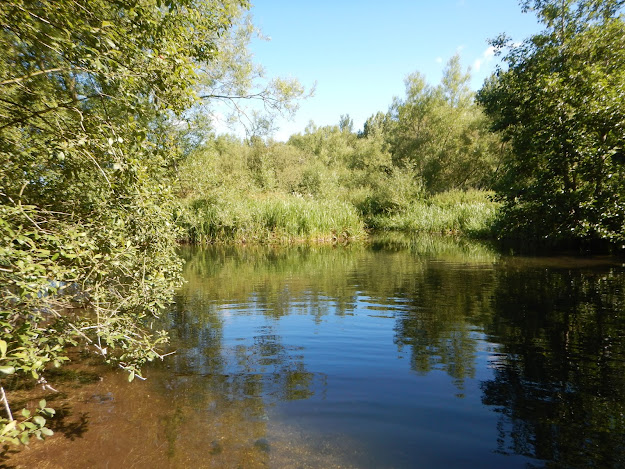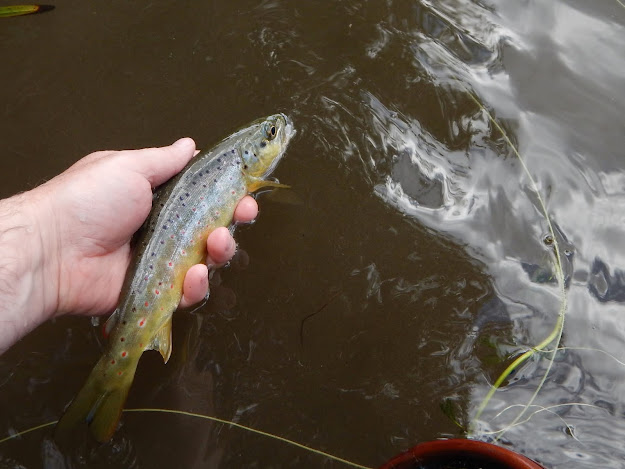River Wylye, Wiltshire
I first met Steve eight years ago when he hosted me for a day on the Peacock Fly Fishing Club's section of the Derbyshire Wye. Steve has since retired to Dorset and is now a member of the historic Wilton Fly Fishing Club which has seven miles of fishing on the River Wylye, its carriers and a tributary. The Wylye rises in Wiltshire and flows east before it joins the Nadder just downstream of the village of Wilton. The Nadder then joins the Avon three miles downstream at Salisbury where it flows due south to the English Channel. These three chalkstreams are the fishing jewels of Wiltshire.
The drive there took me past Stonehenge and I stole furtive glances at the great stone monument whilst whizzing past on the A303. I took the turn off for the village of Great Wishford, a single track farm lane with red poppies flowering in the grassy verges. The road descended from the ridge to the village and river below, and the bucolic vista was gorgeous. Neat rows of beige wheat fields interspersed with rich grazing pastures, hedgerows and woods under a clear blue sky. I met Steve in the village pub's car park and followed his Jaguar convertible down a farm track to our beat.
After catching up on news, I asked Steve how "Wylye" is pronounced. The answer: "Wily", pronounced like the word to describe a clever fox. Quite different to how I had pronounced it with an 'eye' on the end. The English language has some curious oddities. 'Alnwick' where the famous Hardy brand originates, is pronounced 'Annick'. The 'Frome', a chalkstream in Dorset, is pronounced 'Froom'. It's hard enough for me but can you imagine the minefield non English speakers must face when learning the language?
 |
| A deep pool formed by the confluence of the main river and a carrier |
We walked to the river through the fields of a working farm, where sheep were being corralled and shorn of their fleeces. The flock numbered in the hundreds and they made quite a din by bleating incessantly. A barn owl silently flew from the trees lining the river and across the fields, hard to miss being snowy white. We waded into the fringes of the river at a deep pool formed by the confluence of the Wylye and a carrier. Steve carried no rod. As the consummate host, he was simply happy to guide me with the benefit of his local knowledge. The water was glassy smooth and we saw little hint of surface feeding, so I tied a beadhead nymph to my tippet. After a couple of drifts through the deepest water, my line came to life with a 12" grayling on the end. Steve netted the fish and mentioned how it's always nice to catch a fish so early in the day. That's true. As my host, he could now relax.
Near the head of the pool, just before the river's sweeping bend, a fish rose. I tied on a small klinkhamer and a 10" trout duly obliged by taking the fly. Steve is a dry fly only man, so he was very pleased. He mentioned that in his experience the Wylye's resident trout are not particularly free-rising, so this fish was a boon. I also drew a deep sense of satisfaction in catching a trout from a new chalkstream too. Unfortunately, when I got home and uploaded the photos I had taken, something had gone wrong. The close up images of fish were almost all entirely out of focus.
There were several grayling in the same run and one of them was very large. It ignored the klinkhamer but another, smaller, grayling further down the bubble line came up and took the drifting fly. I switched the dry fly for a nymph to target the large grayling, which I trundled past the large fish a few times until it eventually relented and took the fly. Steve excitedly shouted "its moved to take it!" and I struck. I felt the hook bite, saw a flash of brilliant silver in the morning sunlight as the fish recoiled, revealing a broad flank, but then the line disappointingly went limp. That would have been a very good grayling indeed.
As an aside, when I arrived home later that evening a book had arrived for me in the post. 'An Album of the Chalk Streams' by Dr E.A. Barton, published just after the Second World War, features 47 black and white photos which he took with a tripod and bellows camera, very often using a long timer and posing in them himself. Of the section of river where the Wylye (which he spelt "Wiley") and Nadder join, he said "The river holds a fair number of trout, but is principally noted for the abundance of grayling. These are not looked on as "vermin" by the anglers - as in so many other trout streams - but are caught in good numbers in the late summer and autumn." In Charles Rangeley-Wilson's 'Chalkstream' there is an extract from Atwood Clark's diary, written in 1933, which says "There seems to be no record of the date when grayling were introduced to the Wylye. I always thought that they decreased the number of trout because the latter were never so plentiful at Wishford where there were grayling as in those parts of the river in which the latter did not exist." He then wrote of his 'disappointment' to realise the large fish he had brought to his net was 'only a grayling' but 'was tempered later on by the certainty that it was the biggest of its species ever seen in those parts.' It weighed an enormous 3¾ lbs. Ninety years after Clark and 70 years after Barton, I was discovering that this is still a prime, plentiful grayling water.
We were held captive behind a swan whilst it unhurriedly paddled upstream and fed on water weeds. When we took a step forward it would lift its neck like a periscope from under the water and watch us suspiciously, a little infuriatingly keeping a distance by moving upriver to the next clump of weeds. I wondered how fish behaved around swans. Were they accustomed and aware swans posed no threat? Perhaps they welcomed swans rummaging in the weeds, dislodging aquatic morsels? I saw a fish spook as the swan paddled into range and that answered my question. Eventually, we charged up the water and forced the swan downstream of us, and for the next ten minutes, it was a battle of will for pole position which the swan ultimately lost (perhaps only when Steve let out a long hiss!). Finally in the clear, I caught two grayling, the first on a parachute RAB and the second on a Zak nymph. These are two well known South African fly patterns and it was pleasing to learn they worked just fine on an English chalkstream. Just before we paused for lunch, I managed to tempt an 8" trout to rise and take a CDC & Elk from a lovely riffle section of water. I would have placed a bet on a trout taking a fly in that sort of water.
We ate our packed lunches in the shade of a tall oak. A flock of sheep escaped from their pen and bolted past us, bleating loudly, a farm hand desperately trying to stop them. The sheep ran down a dead end to a low bridge over the river with a closed gate at the other end. They pressed and thronged onto the bridge and one even fell over the side. It was a little comical. Eventually, with the aid of a sheep dog and some effort the hands coaxed the sheep back into their pen.
We split up after lunch. Steve headed upstream and I resumed at the same place we had exited the water for lunch. There was an enticingly deep pool and from it I managed to catch two grayling on a weighted hare's ear.
At least three fish were rising just beneath the bridge but I was unable to tempt them to take a fly. Very small white/cream Caenis were hatching, also known as the 'angler's curse', and I suspect the fish were taking them. I moved on and just upstream of the bridge caught another grayling with a nymph from the dark, shaded water under the trees on the true left bank.
With the benefit of my polaroid sunglasses I spotted an enormous fish in a deep, shaded hole under the trees. I could just see the head and left pectoral fin of the fish and I think it was a trout. A fallen tree, lying parallel with the bank, lay immediately upstream, and the hole the fish was sitting in was scoured from the current caused by the tree. I needed to cast a nymph just upstream of the fallen tree, so that it would drift down next to the tree log and spill into the path of the fish. I cast poorly and lost two nymphs to the tree's dry, dead branches, but the fish hadn't seemed to notice. It was still there. I finally landed the fly in the right place, and as it drifted past the log, just about to enter the sweet spot, the indicator checked and I struck into a fish. It was another fish of a much more modest size, which turned downstream, fought valiantly for a second or two and then came off. When I looked back to the hole behind the log, the large fish was gone.
It was a productive section of the river. I caught the largest grayling of the day in the next pool up, and I think quite possibly it may have tipped the scale at 2lbs. I didn't take a photo of it because, in typical grayling fashion, it wouldn't stay still in either my net or hand. When I reached for my camera, it was gone.
It was approaching 5pm when I finished with a trout of 9". It took a hare's ear nymph and it was a lovely moment to finish with. I returned to the large oak and our cars by cutting across a paddock with bleating, recently fleece-less sheep very curious at my presence. Steve had just finished too, and had enjoyed some success. Steve asked about my final tally for the club's extensive records: three trout and seven grayling, with one of the trout and six of the grayling of 10" or more.
We said our goodbyes and the ground reverberated as Steve fired up his eight cylinder car engine. I pulled over at the bridge over the river just below the village and peered into the water on both sides of the road. I could see several trout and grayling from my high vantage point. This is certainly a productive river. On the drive home I reflected on what a pleasant day of company and fishing it had been. Thanks Steve, for the privilege of sampling your club's historic waters.







Justin
ReplyDeleteI've never landed Grayling, I assume the fight is similar to landing a brown. I Googled the klinkhamer and can see why you have success with the fly. Do you fish it with floatant? Thanks for sharing
Hello Bill. I find that grayling and trout fight very differently. Grayling tend to stay deep and shake their heads profusely - rather than running like a trout does. I prefer catching trout but some people here in the UK feel quite the opposite to me! A klinkhamer is a staple for me, and I use floatant on the hackle and post. The body and hook sits under the water and it represents a nondescript emerging insect. Try one on your next visit to the Sipsey, you won't look back!
Delete